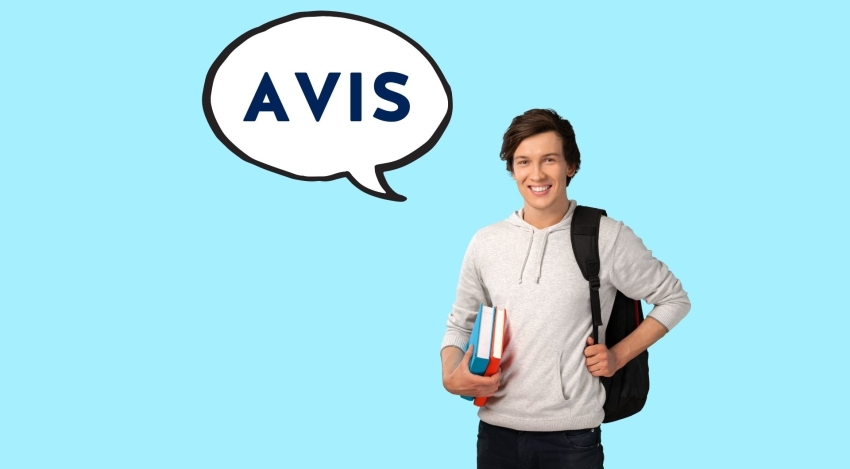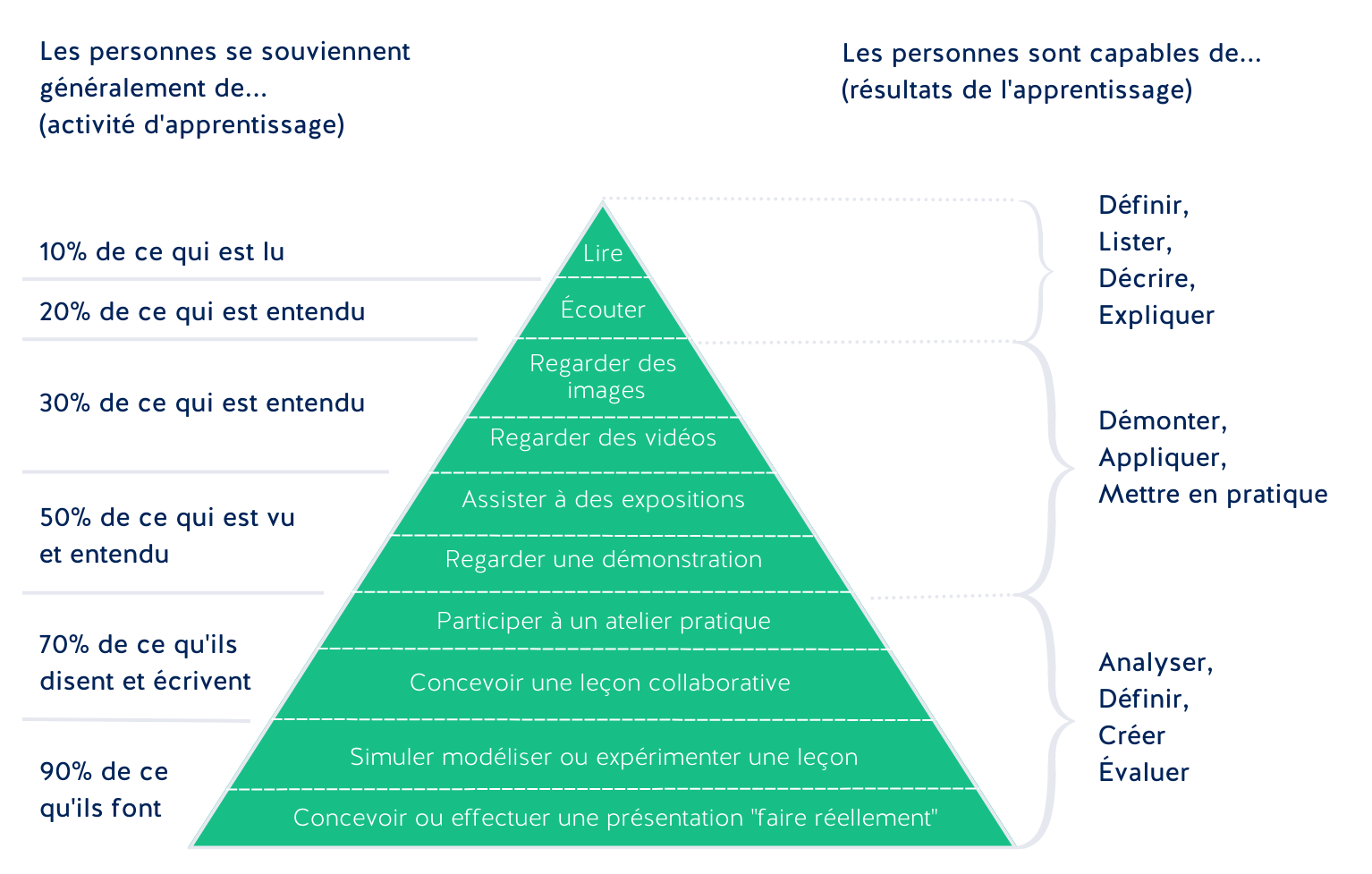

While many articles ponder the best practices to adopt for constructing a digital pedagogical roadmap, the gestures and postures teachers should adopt in front of their screens, how to generate engagement and motivation... far fewer focus on students' experiences with this new pedagogy.
The initial idea is to assume that Generation X and Y are naturally favorable to it, given that they've grown up in this digital flow. However, this is only partially true. Students are indeed digital natives, but not necessarily digital masters! They may not necessarily have the mastery of tools and organization when it comes to a professional context.
Several studies and articles have been compiled here, sources of which will be provided at the end of the article.
First and foremost, let's refresh our memory:
Analyzing these, the last three factors could be part of Edgar Dale's active learning mode.
Most of the time, we find this pattern in the distance learning curricula of institutions. In fact, a teacher who merely comments on a PowerPoint or a PDF file during their video is insufficient to engage a student. An exclusive top-down pedagogy is not perceived favorably by learners. They find themselves alone facing their computer and the given knowledge, with the sole guide being to acquire a new skill. This doesn't engage them in their journey.
For this reason, we recommend collaborative learning or online activities such as mini-games, quizzes, and surveys...
Naturally, when a piece of knowledge is complex to assimilate, students will have an easier time disengaging. Avoiding obstacles is natural for humans. The teacher can't do much about it, and even the best course of the year wouldn't change that. This problem is even harder to manage in a distance learning context, as the teacher can't "sense" their distress and assist them as they would in a physical setting. Additionally, according to Marcel Lebrun's experience at the University of Louvain, not all disciplines are equal in the face of eLearning.
It's crucial to assess students regularly, starting from the beginning of the program. This way, the teacher can identify struggling students and offer better support.
Students need extreme clarity to outline their learning path. Right from the start, they expect a focused path, presented in a way that's almost "pre-chewed" by the teacher. They want to feel that there's someone to answer all their questions in any situation. These needs, however, as emphasized by a Canadian university, are both cognitive and administrative in nature.
From the beginning, provide students with a comprehensive course syllabus. The chapters and titles should be clear and structured. Of course, the teacher should be available to answer emails and can define specific response times for students. The key is not to leave their questions unanswered.
Students are extremely attentive to teacher feedback. In a distance learning context, they expect very rapid, regular, and tailored feedback. In this same Canadian university, students mention that receiving a uniform, "copy-paste" response to their individual requests greatly disappoints them. Responses should be more personalized.
Many students highlight the lack of human warmth. Indeed, in their learning journey, they expect to form strong bonds with their teachers. Feedback, mostly through email or forums and therefore in writing, is perceived as too "cold" by students. They often feel that the teacher is reluctant to develop relationships that go beyond the strictly professional context.
Sometimes, a simple friendly emoji can ease many discomforts. Teachers should also consider introducing themselves, explaining their background to humanize themselves further.
Students often find it harder to express themselves in writing. Thus, some requests for support are set aside to spend more time on completing assignments. Students feel the need for an easy and spontaneous way to seek the teacher's help. Without this, some may feel sidelined, facing their difficulties alone.
In addition to emails, teachers can offer a chat, which is less formal for simple questions. For more complex problems, encouraging learners to turn to their peers can be beneficial. In a distance setting, a spirit of solidarity can be amplified.
Students expect to apply the skills they've acquired during their distance learning program through practical scenarios. This also holds true for traditional learning. They expect the teacher to apply the newly acquired skills almost systematically throughout their journey. When a student is left to themselves, it's harder to expand the field of application. Marcel Lebrun emphasizes, "If we want to assess the impact of technologies, we need to stop evaluating students' knowledge and look at the skills, the abilities they acquire. And therefore create truly new learning methods, with group assignments..."
Students need to discuss with their peers to receive encouragement and, cognitively, to receive feedback on their assignments or exchange ideas on theoretical aspects. Isolation is a dark spot in distance learning. Yet, several institutions have noticed that forums aren't used.
As mentioned earlier, it's complicated for students to express their needs in writing, explicitly representing their ideas. Nonetheless, communication is one of the keys to distance learning.
According to C. Naschberger, Audencia students vacillate between enthusiasm for digital learning and the benefits of in-person learning. While staying at home to learn is undoubtedly comfortable, the problem lies in the (numerous) temptations of home. In-person learning imposes a neutral environment and rules, while distance learning requires strict self-discipline, which not all students possess equally.
If you're considering transforming your learning program into a hybrid or 100% distance mode, we recommend consulting this white paper. It will help you understand how to choose the most suitable mode, ensure pedagogical continuity, and finally support teachers and students in this transformation.
The Canadian case study "Distance Tutoring: What Do Students, Tutors, and Designers Think?" by André-Jacques Deschênes — Pierre Gagné — Hélène Bilodeau — Suzanne Dallaire — François Pettigrew — Maude Beauchesne-Rondeau — Caroline Côté — Martin Maltais — Louise Sylvain — Jacinthe Thériault-Fortier,
Comments from Marcel Lebrun, teacher at the Catholic University of Louvain, and Christine Naschberger, teacher in the Management Department at Audencia.
The article by Pierre Cocheteux, "E Learning, pourquoi 95% des personnes échouent?"





